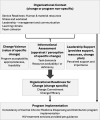Adapting and testing measures of organizational context in primary care clinics in KwaZulu-Natal, South Africa
- PMID: 38886792
- PMCID: PMC11184827
- DOI: 10.1186/s12913-024-11184-9
Adapting and testing measures of organizational context in primary care clinics in KwaZulu-Natal, South Africa
Abstract
Background: Implementation science frameworks situate intervention implementation and sustainment within the context of the implementing organization and system. Aspects of organizational context such as leadership have been defined and measured largely within US health care settings characterized by decentralization and individual autonomy. The relevance of these constructs in other settings may be limited by differences like collectivist orientation, resource constraints, and hierarchical power structures. We aimed to adapt measures of organizational context in South African primary care clinics.
Methods: We convened a panel of South African experts in social science and HIV care delivery and presented implementation domains informed by existing frameworks and prior work in South Africa. Based on panel input, we selected contextual domains and adapted candidate items. We conducted cognitive interviews with 25 providers in KwaZulu-Natal Province to refine measures. We then conducted a cross-sectional survey of 16 clinics with 5-20 providers per clinic (N = 186). We assessed reliability using Cronbach's alpha and calculated interrater agreement (awg) and intraclass correlation coefficient (ICC) at the clinic level. Within clinics with moderate agreement, we calculated correlation of clinic-level measures with each other and with hypothesized predictors - staff continuity and infrastructure - and a clinical outcome, patient retention on antiretroviral therapy.
Results: Panelists emphasized contextual factors; we therefore focused on elements of clinic leadership, stress, cohesion, and collective problem solving (critical consciousness). Cognitive interviews confirmed salience of the domains and improved item clarity. After excluding items related to leaders' coordination abilities due to missingness and low agreement, all other scales demonstrated individual-level reliability and at least moderate interrater agreement in most facilities. ICC was low for most leadership measures and moderate for others. Measures tended to correlate within facility, and higher stress was significantly correlated with lower staff continuity. Organizational context was generally more positively rated in facilities that showed consistent agreement.
Conclusions: As theorized, organizational context is important in understanding program implementation within the South African health system. Most adapted measures show good reliability at individual and clinic levels. Additional revision of existing frameworks to suit this context and further testing in high and low performing clinics is warranted.
Keywords: Cohesion; Critical consciousness; Instrument development; Leadership; Organizational context; Primary care; Reliability; South Africa; Stress; Validity.
© 2024. The Author(s).
Conflict of interest statement
The authors declare no competing interests.
Figures
References
-
- Dionne KY. Doomed Interventions: The Failure of Global Responses to AIDS in Africa. Cambridge: Cambridge University Press; 2017. p. 214.
-
- UNAIDS: Joint UN Program on HIV/AIDS. UNAIDS. 2018 [cited 2019 Dec 11]. UNAIDS: South Africa. Available from: https://www.unaids.org/en/regionscountries/countries/southafrica
MeSH terms
Grants and funding
LinkOut - more resources
Full Text Sources
Medical
Research Materials


